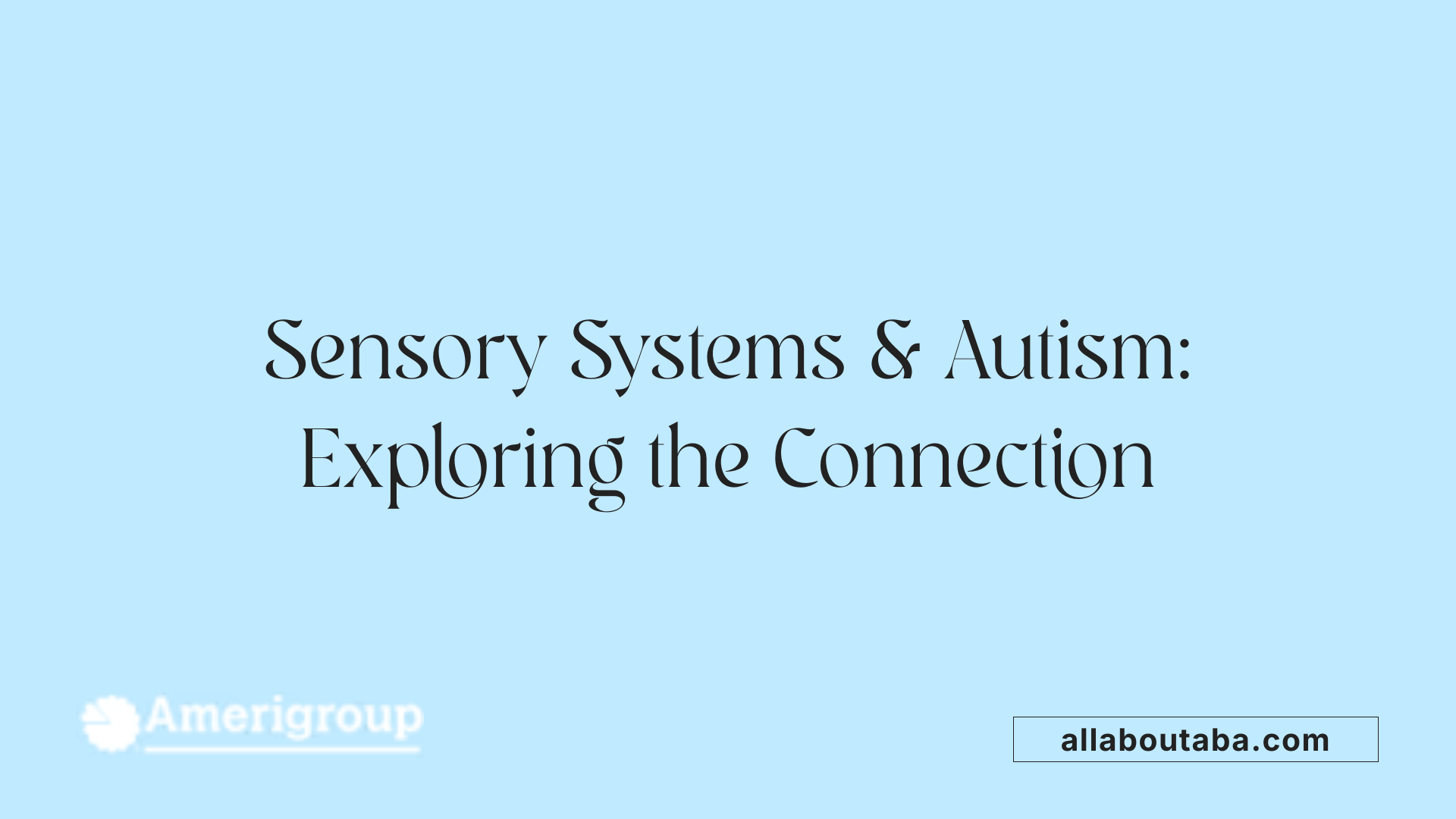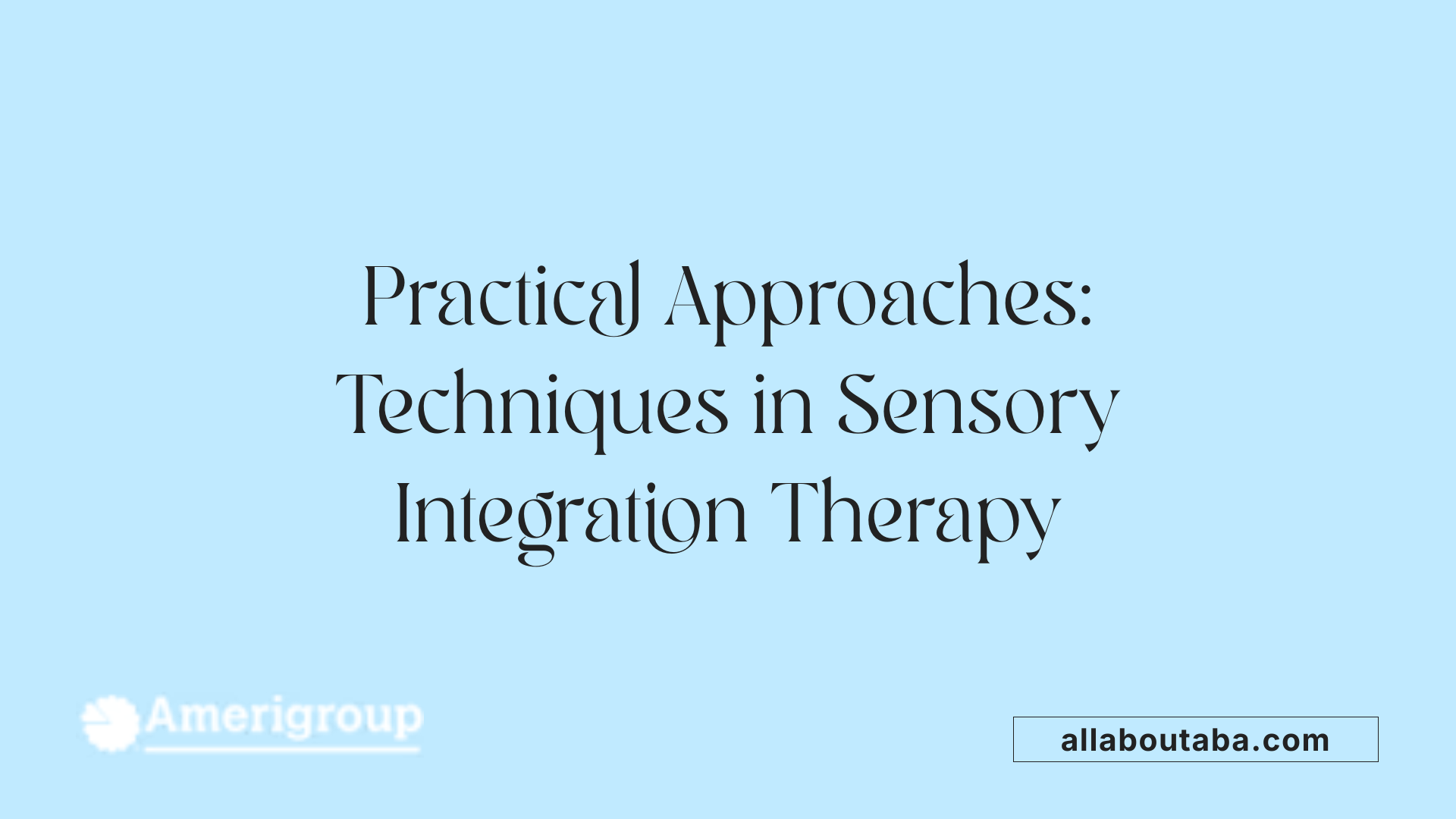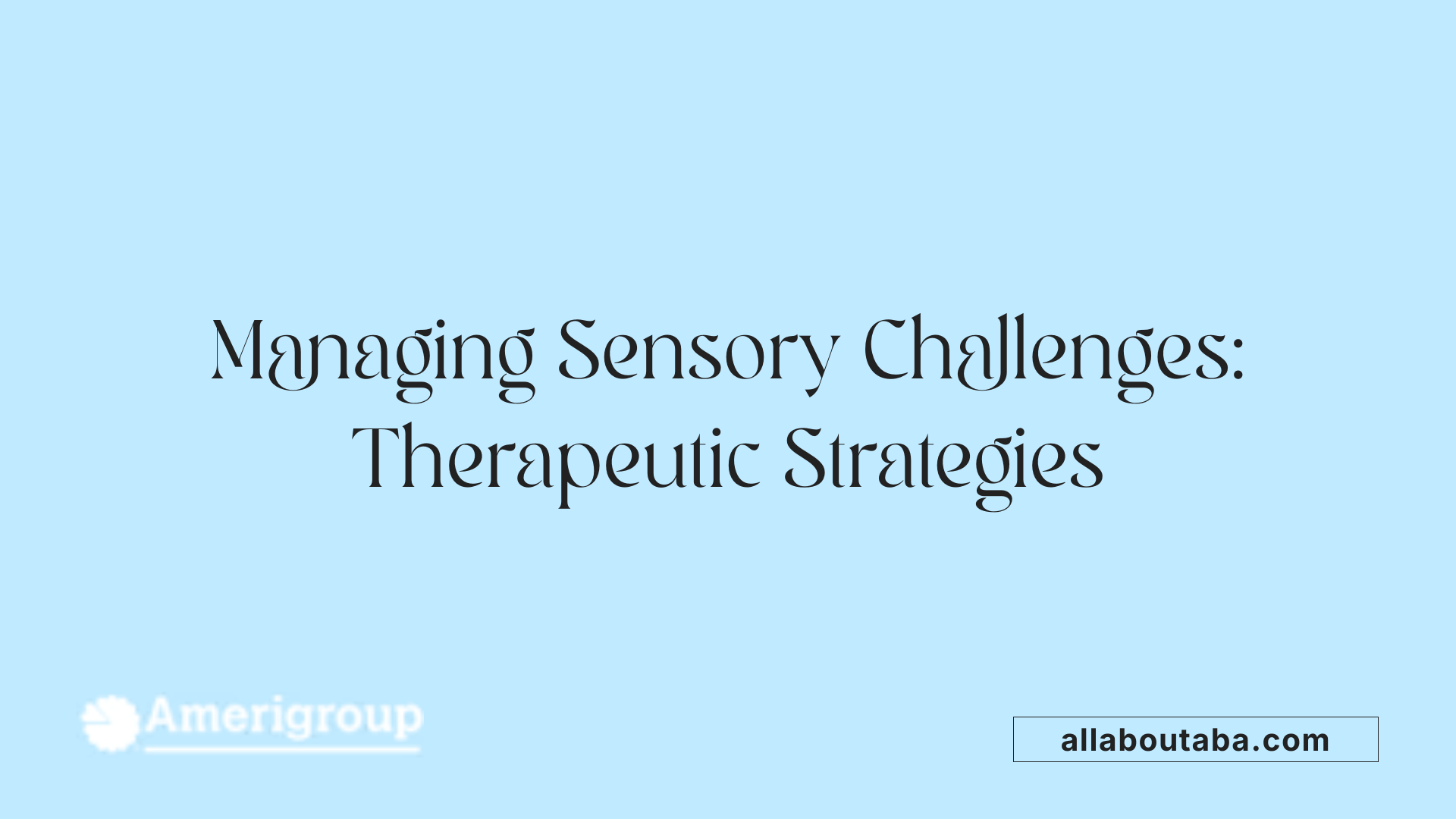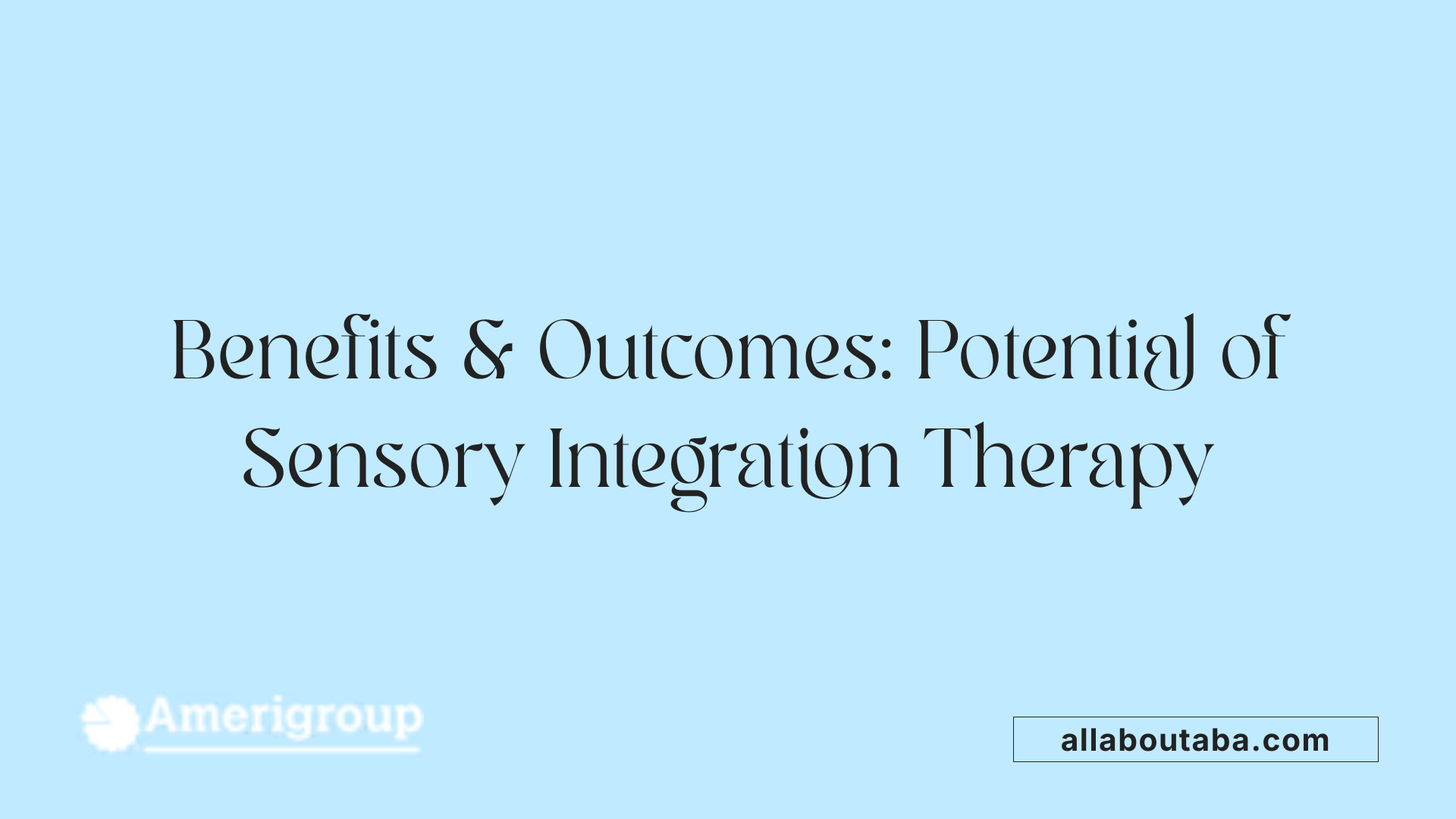An Insight into Sensory Processing and Therapy
Sensory integration therapy (SIT) is a widely used yet scientifically debated intervention aimed at helping individuals with autism manage sensory processing difficulties. Rooted in neurobiological principles, SIT seeks to enhance the brain's ability to organize and interpret sensory input, leading to improvements in behavioral, motor, and social functioning. This article explores the therapy's origins, methodologies, effectiveness, and current scientific standing, providing a comprehensive overview of its application in autism.
Defining Sensory Integration and its Relation to Autism

What is sensory integration?
Sensory integration is a natural neurobiological process where the brain interprets and organizes sensory input received from the environment and the body. It involves managing information from the five senses — touch, sight, sound, taste, and smell — as well as from the vestibular system (balance and movement) and proprioception (body awareness). This complex process allows us to respond appropriately to daily experiences, coordinate movements, and develop social and cognitive skills.
In children, proper sensory integration is crucial for learning, motor development, and behavior regulation. When sensory information is processed efficiently, children can focus, engage in activities, and adapt to their environment with greater ease.
The sensory systems involved (tactile, vestibular, proprioceptive)
Sensory integration revolves around three primary systems:
- Tactile System: Handles sensations from the skin through touch, pressure, and pain. It helps children explore objects and their surroundings.
- Vestibular System: Regulates balance and spatial orientation via the inner ear. It influences movements such as swinging or jumping.
- Proprioceptive System: Provides feedback about body position and movement through sensors in muscles, joints, and tissues. It supports coordination and body awareness.
These systems are interconnected; they work together to create a cohesive sensory experience, enabling motor responses and social interactions.
How sensory processing difficulties manifest in autism
Many individuals with autism experience sensory processing challenges, often described as sensory integration dysfunction. This can manifest in many ways:
- Hypersensitivity (over-responsiveness): Overreacting to stimuli such as loud noises, bright lights, or touch, which can cause distress or withdrawal.
- Hyposensitivity (under-responsiveness): Underreacting to sensory input, leading to self-stimulatory behaviors like rocking, spinning, or hand-flapping as attempts to stimulate the senses.
- Clumsiness or poor coordination: Difficulty integrating sensory input can impair motor skills.
- Behavioral issues: Irritability, distractibility, and difficulty in calming down are common when sensory regulation is disrupted.
Such difficulties can impact communication, socialization, and daily functioning, making sensory integration a focal point of many therapeutic interventions.
What is sensory integration therapy and how does it work for autism?
Sensory integration therapy (SIT), developed by occupational therapist A. Jean Ayres in the 1970s, is a specialized play-based intervention aimed at improving the brain’s ability to process sensory information. It involves engaging children in activities like swinging, bouncing, or climbing, designed to stimulate the tactile, vestibular, and proprioceptive systems.
The goal of SIT is to help children organize sensory inputs more effectively, reducing sensitivities and promoting adaptive responses. Practitioners customize activities to each child's unique sensory profile, helping them manage sensory overloads and under-responsiveness.
While some research indicates that SIT can enhance daily functioning and reduce sensory-related behaviors, the overall scientific evidence remains limited. Many studies have methodological flaws, and large-scale high-quality research is lacking.
Occupational therapists trained in sensory integration techniques evaluate sensory challenges and develop tailored intervention plans. These may include play activities, sensory diets, and the use of equipment such as swings, trampolines, or weighted objects. The therapy aims not only to improve sensory processing but also to support motor development, social skills, and emotional regulation.
What is sensory integration and how does it relate to autism?
Sensory integration, fundamentally, is how the brain organizes and responds to sensory information. In autism, many individuals experience sensory processing difficulties, which can profoundly affect their behavior and development.
Autistic individuals often exhibit atypical responses — either hypersensitivity, where stimuli like sounds or textures are overwhelming, or hyposensitivity, where the same stimuli fail to elicit meaningful responses. These issues may lead to behaviors such as avoidance, self-stimulation, or meltdowns.
Because sensory processing deficits are prevalent in autism, targeting these challenges through therapies that enhance sensory integration can potentially improve overall functioning. However, it’s important to note that the scientific community calls for more rigorous research to support the effectiveness of current sensory-based interventions.
| Aspect | Details | Additional Information |
|---|---|---|
| Main focus of therapy | Sensory-rich activities tailored to individual needs | Development of adaptive responses |
| Fundamental sensory systems | Tactile, vestibular, proprioceptive | Interconnected; essential for daily activities |
| Manifestation in autism | Over- or under-reactivity to stimuli, behavioral challenges | Impact on motor, social, and emotional skills |
| Evidence base | Limited, with mixed research findings | More high-quality studies needed |
| Who delivers treatment | Occupational therapists trained in sensory integration techniques | Also involves family participation |
This understanding underscores both the potential and limitations of sensory integration as an intervention for children with autism, highlighting the importance of ongoing research and individualized approaches.
Techniques and Methodologies in Sensory Integration Therapy

How is sensory integration therapy typically administered, and what techniques are involved?
Sensory integration therapy is usually delivered by trained pediatric occupational therapists or physical therapists, who tailor treatment plans to each child's specific sensory processing needs. They create engaging, play-based sessions that incorporate various techniques to stimulate and regulate the sensory systems.
During therapy sessions, practitioners employ a mix of activities aimed at challenging the child's vestibular, tactile, and proprioceptive responses. These include swinging, which activates the vestibular system and can help improve balance and coordination; spinning activities, which are designed to stimulate the inner ear and awareness of movement; and climbing or balancing on structures like ladders and climbing walls to develop motor planning and body awareness.
A significant component involves deep-pressure techniques, such as massage, brushing protocols, and the use of weighted vests or blankets. These methods provide calming proprioceptive input, which can help reduce anxiety and promote self-regulation.
Tactile stimulation is incorporated through textured materials and brushing routines to enhance tactile discrimination and coping. Additionally, therapists may include activities that engage the auditory and visual senses, such as listening to specific sounds or focusing on visual stimuli.
These activities are often part of a structured sensory diet—a personalized schedule of sensory activities designed to provide the right type and amount of sensory input throughout the day. This approach helps children maintain optimal arousal levels, regulate behaviors, and improve overall sensory integration.
Environmental modifications, like managing lighting, reducing background noise, or providing textured surfaces, are used to create a supportive environment that fosters successful engagement in sensory activities. Throughout the therapy, therapists continuously evaluate and adjust activities based on the child's responses, ensuring progress in sensory processing and functional skills.
Overall, the combination of active play, specialized equipment, and environmental strategies forms a comprehensive methodology to support sensory integration and promote developmental gains.
What are the typical activities and tools used in sensory integration therapy?
The core activities of sensory integration therapy are designed to provide meaningful sensory input that helps organize the brain's response to sensory stimuli. Commonly used activities include swinging on hammocks or swings, bouncing on therapy balls or trampolines, and spinning on rotating devices or while spinning oneself, all aimed at stimulating the vestibular system and improving balance.
Climbing and balance activities, such as navigating obstacle courses or using climbing walls, are used to enhance strength, coordination, and spatial awareness. These physical activities not only challenge the motor system but also promote integration of sensory input.
Therapists utilize a variety of tools to deliver targeted sensory input. Weighted vests, blankets, and lap pads provide deep pressure, which can have a calming effect and help with self-regulation. The brushing protocol involves gentle tactile brushing on specific body areas, aiming to desensitize over-reactive skin responses and improve tactile discrimination.
Other tools and equipment include textured toys and materials for sensory exploration, oral-motor chewy objects for tactile stimulation in the mouth, and auditory devices like headphones with filtered sounds for auditory integration tasks.
Sensory diets are personalized sequences of activities that include these tools and techniques, scheduled throughout the day to maintain balanced sensory input.
Environmental modifications also play a crucial role. These may involve adjusting lighting to be softer, creating quiet zones to reduce overstimulation, and using textured surfaces or visual cues to assist sensory learning.
In family-centered approaches, parents are often guided to incorporate these activities and tools into daily routines, supporting the child's progress outside of structured therapy sessions. This comprehensive approach aims to improve sensory regulation, reduce challenging behaviors, and enhance participation in everyday activities.
How Sensory Integration Therapy Manages Sensory Processing Challenges

How does sensory integration therapy help manage sensory processing challenges in autism?
Sensory integration therapy (SIT) is designed to assist children with autism in managing their sensory sensitivities through carefully structured activities and sensory stimuli. By engaging in specific movements such as swinging, bouncing, or climbing, children can enhance their ability to interpret and respond to sensory information. Techniques like skin brushing or joint compressions are also incorporated to address hypersensitivity or hyposensitivity.
Therapists often set up a sensory-rich environment, commonly in a specialized sensory gym, where activities are tailored to the child's particular sensory needs. This controlled setting allows children to engage safely while gradually improving their tolerance to various stimuli. Many families observe that children become more comfortable in everyday environments, experience fewer emotional meltdowns, and show increased participation in daily tasks.
While debates about the underlying neuroplasticity effects of SIT persist, anecdotal reports suggest it can lead to better emotional regulation and adaptive responses. The ultimate goal of the therapy is to support autistic individuals in achieving more effective sensory regulation, promoting greater independence and improved quality of life.
What is the proposed mechanism by which sensory integration therapy influences sensory challenges?
The core idea behind SIT’s influence on sensory difficulties is centered around the brain's ability to adapt, known as neuroplasticity. The therapy involves providing consistent, sensory-rich experiences that aim to reorganize neural pathways responsible for processing sensory information.
Activities used in SIT—such as swinging, deep pressure, or visual stimulation—are believed to help desensitize overreactive responses and boost under-responsive sensory systems. Although the scientific evidence supporting this mechanism is limited, it is hypothesized that these activities facilitate improved registration, modulation, and integration of sensory stimuli.
This targeted sensory engagement encourages the brain to better tolerate external stimuli, reducing maladaptive behaviors like sensory seeking or defensiveness. Over time, these neural changes may help individuals develop more adaptive responses, leading to enhancements in daily functioning, emotional stability, and social participation.
How activities reduce sensitivities
Activities used in sensory integration therapy aim to modulate sensory sensitivities through controlled stimulation. For hypersensitive children, activities involve gradual exposure to stimuli such as noise, touch, or movement, helping to decrease over-responsiveness. For hyposensitive children, activities provide intense, purposeful sensory input to increase awareness and responsiveness.
For example, swinging or bouncing provides vestibular input, which can help reduce balance issues and clumsiness. Deep pressure activities, like using weighted vests or blankets, promote calming effects by stimulating proprioceptive receptors. Tactile activities, such as textured play or brushing protocols, help desensitize touch sensitivities.
Through repeated practice and gradual exposure, these activities aim to normalize sensory processing, decreasing distress and improving comfort levels in various settings, including home, school, and social environments.
Creating structured, sensory-rich environments
A vital aspect of SIT involves setting up structured environments that are rich in sensory stimuli but within safe and predictable boundaries. These environments often feature equipment like swings, trampolines, and climbing structures, where children can engage in sensory activities tailored to their needs.
Therapists carefully organize routines to include sensory diets—individual plans that outline specific activities and their timing to support sensory regulation throughout the day. The structure helps children anticipate what will happen, reducing anxiety and enhancing cooperation.
Creating such environments encourages exploration and self-regulation. It helps children learn to control their responses, transition between activities smoothly, and develop tolerance to different sensory inputs. Structured, sensory-rich settings can be adapted over time based on progress and changing needs, promoting sustained improvements.
Fostering adaptive responses and emotional regulation
Beyond modulating sensory sensitivities, SIT aims to foster adaptive responses that support emotional stability. When children engage in sensory activities that are appropriately challenging, they can learn to manage overwhelming stimuli more effectively.
For example, rhythmic swinging might help soothe a child during times of distress, while engaging in tactile play can redirect inappropriate self-stimulatory behaviors into functional activities. Over time, children develop strategies to self-regulate their emotions and behaviors, especially in situations that previously caused sensory overload.
Therapists often incorporate calming techniques and teach coping strategies, such as deep breathing or movement breaks, to strengthen emotional resilience. This focus on emotional regulation helps children navigate complex social and environmental demands, improving their overall functioning and well-being.
Potential Benefits and Outcomes of Sensory Integration Therapy

What are the potential benefits of sensory integration therapy for individuals with autism?
Sensory integration therapy (SIT) has been explored as a supportive approach for children with autism spectrum disorder (ASD). Although the scientific evidence remains limited, many practitioners, parents, and clinical observations suggest several positive outcomes.
One of the primary benefits is the improvement in sensory processing and regulation. Children who undergo SIT often show better tolerance to sensory stimuli, which can lead to reduced sensory sensitivities and over-responsiveness. This might manifest as fewer tantrums, meltdowns, or behavioral outbursts caused by sensory overload.
Additionally, the therapy can foster emotional regulation and coping skills. As children learn to process sensory input more effectively, they often experience decreased anxiety and frustration, making daily environments less overwhelming.
Improved attention, focus, and participation in daily activities are also associated with sensory integration therapy. By addressing underlying motor and sensory challenges, children may become more engaged in learning and play.
Furthermore, SIT promotes better social interactions and independence. When sensory challenges lessen, children may find social situations easier to navigate, which can enhance their social skills and confidence.
While anecdotal reports and some small studies point toward these potential benefits, it is important to recognize that the current scientific evidence does not definitively confirm long-term or universal improvements.
What do clinical and research studies suggest about its effectiveness?
The research landscape on sensory integration therapy is characterized by mixed results and methodological limitations. Systematic reviews, such as the one conducted by Randell et al. in 2022, highlight that many available studies have issues like small sample sizes, lack of proper controls, and inconsistent protocols, making it difficult to draw firm conclusions.
Some studies report positive short-term effects, including improvements in sensory processing, motor skills, and adaptive behaviors. For example, certain children showed enhanced participation in daily routines and better regulation of responses to environmental stimuli.
However, larger and more rigorous randomized controlled trials are scarce. These high-quality studies are essential to establish sustained benefits and clarify which children might benefit most.
The American Academy of Pediatrics and other organizations emphasize that current evidence does not support routine use of SIT as a proven treatment for autism. Instead, they recommend practitioners and families consider it as one part of a comprehensive intervention plan, while emphasizing the importance of ongoing assessment and goal-setting.
In summary, although many clinicians observe positive changes, the overall scientific consensus remains cautious due to the low quality and limited scope of existing research. Further well-designed studies are necessary to determine the real long-term effectiveness of sensory integration therapy for children with autism.
Origins, Theoretical Foundations, and Current Research on Sensory Integration Therapy

What are the origins, purpose, and theoretical basis of sensory integration therapy in the context of autism?
Sensory integration therapy (SIT) has its roots in the pioneering work of A. Jean Ayres, an occupational therapist, who developed the approach during the 1970s. Ayres' foundational theory posits that difficulties in processing and organizing sensory information—particularly within tactile, vestibular, and proprioceptive systems—are central to many behavioral and developmental issues observed in children with autism.
The primary purpose of SIT is to help children better process sensory stimuli, which in turn can support improvements in motor skills, social interaction, and behavior. The therapy involves engaging children in activities that stimulate the senses, such as swinging, bouncing, or climbing, aiming to promote neural responsiveness and integration.
The theoretical basis of this approach emphasizes that impairments in sensory registration, modulation, and integration can hinder a child's ability to respond appropriately to their environment. Ayres' theory suggests that by providing targeted sensory experiences, the brain's capacity to process sensory information can be enhanced, leading to better regulation of sensory input and improved overall function.
While neuroimaging studies provide some support—showing atypical connectivity in sensory-related brain regions—scientific evidence for the overall effectiveness of SIT remains limited. The current research landscape indicates a need for more high-quality, randomized controlled trials to draw definitive conclusions.
Nevertheless, the approach remains widely used, especially by occupational therapists, who see firsthand how sensory-rich activities can influence a child's engagement and adaptive behaviors. These interventions aim to create a more manageable sensory environment and teach children to respond more effectively to sensory stimuli, potentially reducing behavioral issues and supporting developmental progress.
What is the origin of sensory integration therapy, and who developed it?
Sensory integration therapy was developed by A. Jean Ayres in the 1970s. Drawing on her neurobiological research, Ayres proposed that sensory processing difficulties could significantly impact learning, motor coordination, and social behaviors.
Her approach emphasizes that sensory systems—particularly tactile, vestibular, and proprioceptive—are interconnected and crucial for daily functioning. Ayres believed that deficits in how the brain interprets sensory input lead to observable challenges in children with developmental disorders, including autism.
To address these challenges, she designed playful, sensory-rich activities that stimulate these systems, such as swinging, bouncing on therapy balls, or climbing equipment, aiming to improve the brain’s ability to organize and process sensory information more effectively.
Although scientific evidence supporting the efficacy of SIT is still emerging and somewhat inconclusive, Ayres' innovative work laid the groundwork for many subsequent occupational therapy practices that focus on sensory processing and integration.
Current Research Limitations and the Need for Further Studies
Despite widespread clinical use, the scientific validation of sensory integration therapy remains limited. Many existing studies suffer from methodological flaws, small sample sizes, and inconsistent measurement tools, which challenge the ability to draw definitive conclusions.
A systematic review of intervention studies found that only a few suggested benefits, and many lacked rigorous controls. Out of 25 analyzed studies, only three indicated that SIT was effective, while others reported mixed results or no benefits at all.
Furthermore, some research points to potential adverse effects, such as increased self-harming behaviors, emphasizing the importance of cautious application.
Organizations like the American Academy of Pediatrics acknowledge these limitations and advise practitioners to carefully monitor progress and set specific, measurable goals when implementing SIT.
The current consensus underscores the necessity for high-quality, large-scale randomized controlled trials. These would clarify which populations most benefit, the optimal intervention intensity and duration, and whether SIT produces long-term improvements.
In summary, while sensory integration therapy continues to be a popular approach among clinicians and families, ongoing research is essential to establish its true efficacy and best practice guidelines. The future of SIT depends on rigorous scientific investigations that can confirm its benefits and inform its application in autism and sensory processing disorders.
The Role of Professionals, Resources, and Ethical Considerations

What is the role of therapists and treatment settings in delivering sensory integration therapy for autism?
Occupational therapists and physiotherapists are central to administering sensory integration therapy (SIT) for children with autism. Their primary role involves conducting detailed assessments to pinpoint specific sensory processing issues, such as hypo- or hyper-responsiveness to stimuli like touch, sound, or movement.
Based on these evaluations, they develop personalized intervention plans that are tailored to each child's unique sensory profile and developmental level. These plans often include sensory-motor activities like swinging, bouncing, or climbing, designed to stimulate and organize sensory input.
Therapists utilize play-based and engaging strategies rooted in neuroplasticity—the brain’s ability to change and adapt—to promote neural organization, motor planning, and emotional regulation. Treatment is usually delivered in clinical settings, including specialized therapy centers or schools, but can also involve activities at home with parental involvement.
Throughout therapy, these professionals collaborate closely with families and multidisciplinary teams to ensure consistency and monitor progress. Their expertise helps children improve their sensory responses, behavioral regulation, and ability to participate in daily routines.
What resources and guidelines are available for understanding sensory integration therapy?
A range of resources support practitioners, families, and educators in understanding and implementing sensory integration therapy. Professional organizations such as the American Occupational Therapy Association (AOTA) provide official guidelines, practice standards, and curriculum resources to ensure safe and effective interventions.
Scientific literature—including peer-reviewed journals and research summaries—offers evidence on the potential benefits and limitations of SIT, emphasizing the importance of evidence-based practice.
Educational materials from reputable institutions like the UC Davis MIND Institute and autism support organizations include articles, webinars, and toolkits that explain sensory processing difficulties and therapeutic strategies.
Organizations such as the Sensory Processing Disorder Foundation and Autism Research Institute (ARI) also publish comprehensive information on assessment techniques, intervention methodologies, and latest research developments, aiding clinicians and families in informed decision-making.
Are there any ethical or scientific debates surrounding the use of sensory integration therapy?
Yes, debates persist within both scientific and ethical domains regarding the validity and application of sensory integration therapy. The primary concern is the limited high-quality evidence supporting SIT’s efficacy. Many systematic reviews reveal that existing studies often suffer from methodological flaws, such as small sample sizes, lack of control groups, and inconsistent outcome measures.
Given this, authoritative bodies like the American Academy of Pediatrics (AAP) advise caution, recommending that SIT should not be used as a standalone or routinely implemented intervention outside of research settings. The debate centers on whether the anecdotal positive reports from parents and clinicians justify broader clinical use without robust scientific validation.
Ethical considerations also include respecting individual differences and avoiding the use of unproven or potentially harmful practices. Ensuring that families are fully informed about the uncertain benefits of SIT before committing resources is a key ethical obligation.
Furthermore, proponents emphasize the importance of integrating sensory interventions within comprehensive, evidence-based treatment plans, while critics call for more rigorous research—such as large-scale randomized controlled trials—to determine true effectiveness.
In summary, while many see potential benefits in sensory integration therapy, ongoing scientific scrutiny and ethical reflection highlight the need for cautious application and further research to validate its role in autism intervention.
Summary and Future Directions
While sensory integration therapy remains a popular intervention for managing sensory processing challenges in autism, current scientific evidence does not conclusively support its widespread efficacy. Developed from neurobiological theories in the 1970s, SIT involves multi-sensory activities tailored by trained professionals to improve sensory regulation and functional behaviors. Despite mixed research results and methodological concerns, many families report improvements in daily functioning, emotional regulation, and social participation. Moving forward, rigorous, large-scale studies are needed to clarify its long-term benefits and establish standardized protocols. Alongside ongoing research, clinicians and families should weigh the potential benefits against the limited evidence, using sensory integration therapy as part of a comprehensive, individualized intervention plan. Promoting scientifically validated practices and ethical considerations will be key to optimizing outcomes for children and adults with autism.
References
- Introduction - Sensory integration therapy for children with autism ...
- Sensory Integration in Autism Spectrum Disorders
- Sensory integration therapy for children with autism and ... - PubMed
- Sensory-Based Therapies | Kennedy Krieger Institute
- Study finds sensory integration therapy benefits children with autism
- Sensory integration therapy & autism | Raising Children Network
- Sensory Processing and Sensory Integration in Individuals with ASD
- What is Sensory Integration Therapy for Children with Autism?
- Sensory Integration Therapy in Paediatric Rehabilitation - Physiopedia







